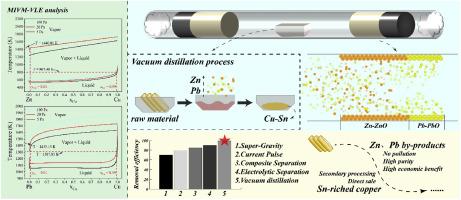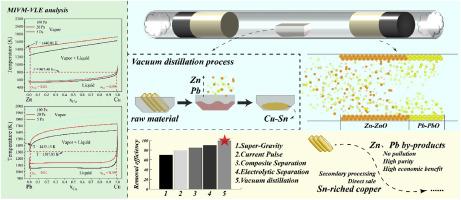协同真空蒸馏从铅铜废料中分离和回收锌铅
IF 10
1区 环境科学与生态学
Q1 ENGINEERING, ENVIRONMENTAL
引用次数: 0
摘要
不断增长的社会铜储量加强了对可持续回收的关注。无铅黄铜的日益普及取代了含铅黄铜合金,将大量的铜重新导向回收市场。火冶法仍然是铜回收的主要方法。然而,从含铅黄铜中回收关键金属的效率很低。真空冶金提供了一种变革性的替代方案,利用精确的相分离能力和最小的环境足迹来克服这些限制。本研究采用分子相互作用体积模型(MIVM)计算了铜合金中Zn和Pb的热力学参数。绘制了饱和蒸汽压曲线、分离系数曲线和汽液平衡图。结果表明,在一定条件下,真空蒸馏的最佳温度范围为1307.85 ~ 1435.15 K,真空压力为20 ~ 39 Pa,可以有效地分离Zn和Pb。单因素实验结果表明,最佳挥发条件为1373 K、20 Pa、30 min, Zn和Pb的挥发率分别为99.38%和95.09%。结果表明,在此条件下,Zn和Pb的冷凝温度分别为473 ~ 541 K和575 ~ 673 K。冷凝产物具有较高的可回收性和经济价值,突出了真空冶金可持续金属回收的潜力。本文章由计算机程序翻译,如有差异,请以英文原文为准。


Synergistic vacuum distillation separation and recovery of zinc and lead from leaded-brass scrap
Growing societal copper reserves have intensified the focus on sustainable recycling. The rising adoption of lead-free brass has displaced leaded brass alloys, redirecting substantial quantities to the recycling markets. Pyrometallurgy remains the dominant copper recovery method. However, it is inefficient in reclaiming critical metals from leaded brass. Vacuum metallurgy offers a transformative alternative, utilizing precise phase separation capabilities and a minimal environmental footprint to overcome these limitations. In this study, we employed the molecular interaction volume model (MIVM) to calculate the thermodynamic parameters of Zn and Pb in copper alloys. Subsequently, we plotted the saturated vapor pressure curves, separation coefficient curves, and vapor-liquid equilibrium diagrams. The results demonstrate that Zn and Pb can be efficiently separated via vacuum distillation under specific conditions, with an optimal temperature range of 1307.85–1435.15 K and a vacuum pressure of 20–39 Pa. Single-factor experiments identified the optimal conditions as 1373 K for 30 min at 20 Pa, achieving volatilization rates of 99.38 % for Zn and 95.09 % for Pb. Our findings further reveal that under these conditions, the condensation temperatures for Zn and Pb were approximately 473–541 K and 575−673 K, respectively. The condensed products exhibit high recoverability and economic value, highlighting the potential of vacuum metallurgy for sustainable metal recycling.
求助全文
通过发布文献求助,成功后即可免费获取论文全文。
去求助
来源期刊

Journal of Cleaner Production
环境科学-工程:环境
CiteScore
20.40
自引率
9.00%
发文量
4720
审稿时长
111 days
期刊介绍:
The Journal of Cleaner Production is an international, transdisciplinary journal that addresses and discusses theoretical and practical Cleaner Production, Environmental, and Sustainability issues. It aims to help societies become more sustainable by focusing on the concept of 'Cleaner Production', which aims at preventing waste production and increasing efficiencies in energy, water, resources, and human capital use. The journal serves as a platform for corporations, governments, education institutions, regions, and societies to engage in discussions and research related to Cleaner Production, environmental, and sustainability practices.
 求助内容:
求助内容: 应助结果提醒方式:
应助结果提醒方式:


